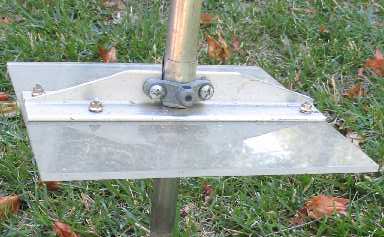Falling Plate Meter
The falling plate meter (Barnhart 1998, Rayburn and Lozier 2003a,b) is a fairly simple device that can be used to rapidly measure forage height and estimate forage biomass nondestructively within plots. We have used a modified falling plate meter to measure grazing impacts and vegetation height in vernal pools and adjacent annual grasslands (Swiecki and Bernhardt 2008) and in other upland annual grasslands. We were also able to use the falling plate meter to measure the height of submerged vegetation in vernal pools during the wet season as shown in the image above.
The forage biomass estimate is made by dropping the plate and allowing it to compress the vegetation to the point where the vegetation rebounds from light compression. For a given type of herbaceous vegetation, the height of the compressed vegetation is typically proportional to biomass.
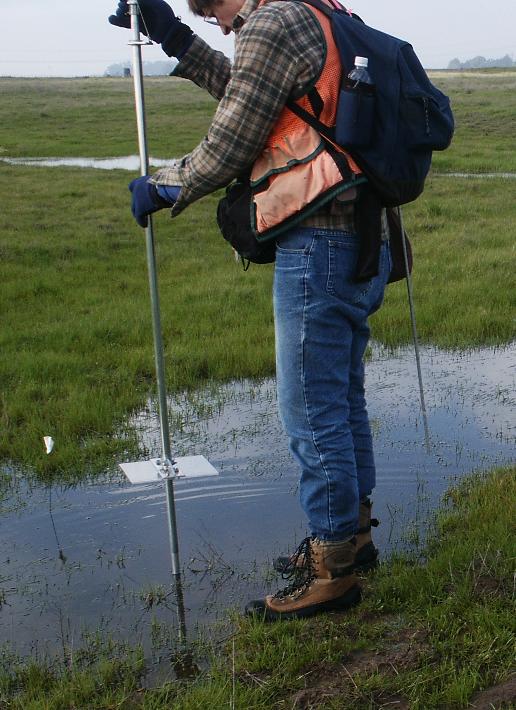
To establish a quantitative relationship between dropped plate heights and biomass, it is necessary to establish a calibration curve. This can be done by measuring dropped plate height at a number of points (preferably at least 18) that represent the range of biomass levels that will be encountered within a the vegetation type under study. A fixed area sampling frame (for example, 30 cm square) is then laid over the measured point and is destructively sampled by clipping it to ground level. The air-dry (100 -120 F) weights of the clippings are then measured and plotted against dropped plate heights to establish a calibration curve.
Separate calibration curves should be developed for different types of vegetation and for the green versus the dry state of a given vegetation type. The image to the right shows a dropped (compressed) reading being made on dry vegetation within a small grazing exclosure.
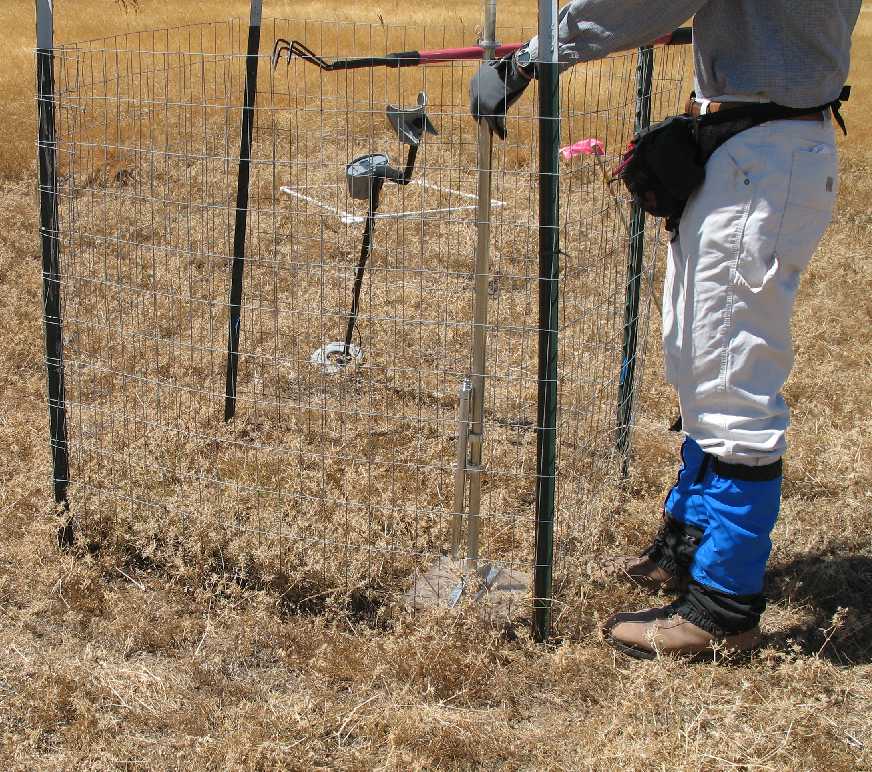
The tool

The falling plate meter we developed consists of a clear acrylic plate with a hole in the center mounted perpendicular to a length of rigid steel tubing. A second length of steel tubing with a tapered closed end slides within the tubing with the attached plate. This inner piece of tubing is calibrated with 1 cm markings that are read at the top of the tubing with the attached plate. This tool simply allows one to record the distance between the ground (where the tip of the inner tube rests) and the plate, which is held at the mean level of the top of vegetation to measure height or rests on the compressed vegetation to permit estimation of biomass.
Why use this tool instead of a measuring stick for simple height measurements? Two advantages:
(1) the plate allows one to estimate the average height of the top of the the vegetation over a discrete area, providing more repeatable and representative height measurements;
(2) since measurements are made at the top of the plate-attached rod, it isn't necessary to bend over to make measurements of low vegetation.
We constructed our falling plate meter from the following materials:
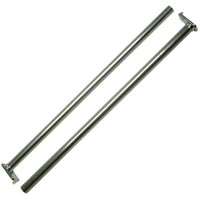 |
- Zinc-plated steel extension closet rod (Stanley 7-120 Zinc Extension Closet Rod) This consists of 2 open pieces of tubing, one of which nests closely within the other. We cut the larger diameter tubing (2.54 cm=1 inch OD) piece to a length of 122 cm (48 inches). The smaller tubing (2.024cm = 0.88 inch OD) was cut to 157.5 cm (62 inches) and the bracket on the end was removed. |
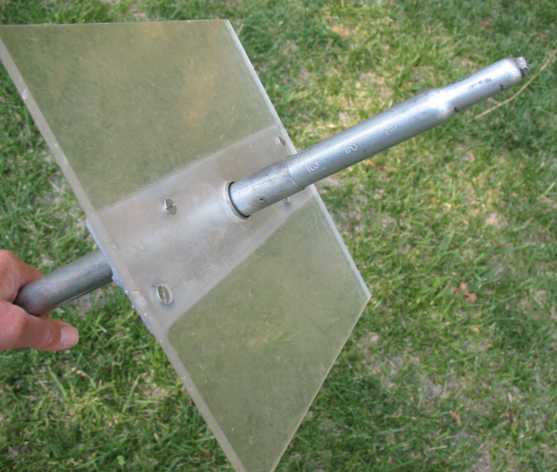 |
The smaller (sliding) tubing needs to have a stable and somewhat narrow closed end in order to rest flat on the soil surface. The tip shouldn't be too narrow, or it will dig into the soil surface (especially if the soil is wet) and result in inflated height readings. We used an old bicycle seatpost (from an ancient Schwinn Varsity if you want to know). The seatpost fit tightly into the inner tubing piece and was secured with a single pop rivet, which was flattened further with a hammer to prevent it from rubbing on the outer tubing. We tapped the open hole on the end of the seatpost and threaded a hex-head bolt into it to provide a solid tip. |
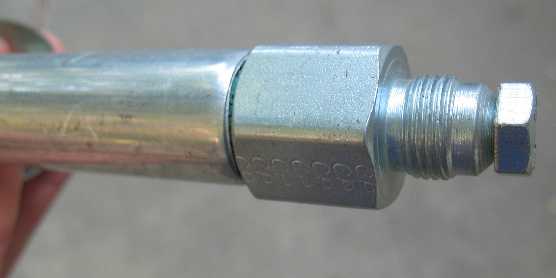 |
Our original meter was sized to measure heights up to 46 cm. To measure greater heights, we constructed an extension tip that slipped over the narrower seatpost tubing but was the same diameter as the inner sliding tubing. Since the inner tube did not need to slide all the way into the outer tube (with the extension, the zero height calibration became 30 cm, the lowest height measurable with the extension attached), we could get by using a tip that would not slide into the the outer tubing. We used a pipe thread-flared compression gas supply fitting, with the threaded end fitting inside the tubing. As before, we used a bolt to form a closed flat tip. If a grinding wheel was used to round off the the hexagonal portion of the fitting, this could be used as a tip that would measure to the zero (ground level) point. |
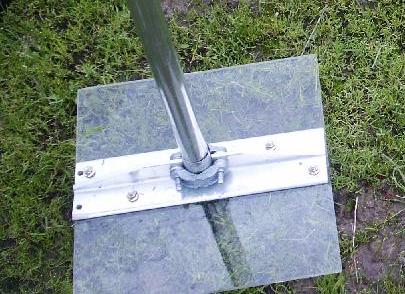 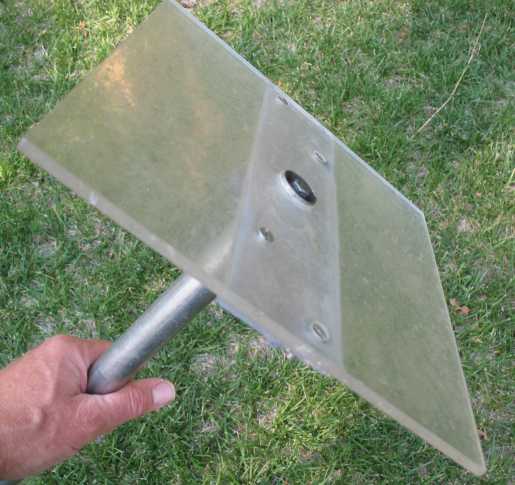
|
The business end of the falling plate meter is of course the plate itself. Ours is a 25 cm square of 5 mm (1/4 inch) thick clear acrylic sheet. We had originally used a thinner material, but it cracked after an impact after only a few days. The plate has a central hole just large enough for the outer tubing to fit snugly through. Attaching the outer tubing to the plate in a stable fashion is probably the most critical design consideration in building this device. We used a piece of aluminum T angle with a hole in the center that was bolted to the plate with countersunk beveled machine screws. The angle was secured to the tubing using an electrical grounding clamp that screwed through the angle upright. The trick here is to have a tight connection, but not to deform the tubing, which would interfere with the sliding of the inner tube. As shown in the photos, we used washers and an aluminum shim to get the correct fit. |
 |
This detail shows the calibration marks on the inner tube, which were etched into the metal surface with an engraver. Because this tube slides up and down the outer tube, markings that are only drawn on will wear off pretty fast. Our measurements are made from the top of the acrylic ring that rests on the bracket and slides freely along the inner tube. It provides a cleaner reading that the somewhat sloppy interface between the inner and outer tubes. |
 
|
A final enhancement to the tool is a cord that serves to lock the sliding tube in place for transport, etc. It also keeps the two tubes together as a unit. A nylon cord is tied to the bracket that is attached to the top of the outer tube. The cord runs through a spring clamp (the type that are used to tighten drawstrings and similar things) and down into the inner tube. Some fishing weights at the end of the string allow the string to be pulled into the tube when the clamp is opened by pushing the black button. They also keep the string from being pulled out. The spring clamp is mounted in a couple of PVC fittings which are attached to the top of the inner tube via an EMT conduit fitting (F slip to MPT). A couple of metal screws going into the wall of the inner tube are used to make sure that this fitting stays in place. |
That's pretty much it. There are obviously a number of ways to vary the construction. This particular model has worked well for taking thousands of readings in the field.
References
Barnhart, S. K. 1998. Estimating available pasture forage. Iowa State University Extension-Ames, Iowa. PM 1758. Available: http://www.extension.iastate.edu/Publications/PM1758.pdf
Rayburn, E. and Lozier, J. 2003a. Estimating Pasture Forage Mass From Pasture Height. West Virginia University Extension Service. Unnumbered publication dated October 2003. Available: http://www.wvu.edu/~agexten/forglvst/passmass.pdf
Rayburn, E. and Lozier, J. 2003b. A falling plate meter for estimating pasture forage mass. West Virginia University Extension Service. Unnumbered publication dated November 2003. Available: http://www.wvu.edu/~agexten/forglvst/fallplate.pdf
